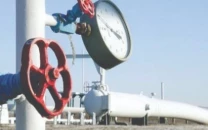Sindh police want forensic laboratory to bolster investigations
Department wants a facility that matches the Punjab police’s laboratory

A new laboratory, made as per international standards, will aid in the prosecution of criminal cases, especially terrorism cases, in Sindh. PHOTO: REUTERS
In the previous budget, the Sindh police had decided to establish their own forensic laboratory on international standards. Unfortunately, despite the proposal being accepted and funds allocated for it, the project was not completed.
"There are some reasons why the laboratory has not been established yet but that does not mean that the money is gone. It is still there and now the allocation has been revised for this year," explained the Sindh police's finance department chief, DIG Imran Yaqoob Minhas.
A home department official said that the government had allocated funds for the project but after that it became the responsibility of the police department to establish the laboratory. "Every project is developed in four phases. The police department did not even initiate the first phase. So how could the money be utilised?" asked a senior official of the provincial home department. "This time, they demanded the same amount for the same purpose and the government allocated the same budget for the same project. Let's see what the Sindh police department does this time," he said.
Sindh police takes a trip down memory lane
The finance DIG, on the other hand, said that this time, the police department has initiated and completed the first phase of the project and now the ball in the government’s court. It needs to approve the first phase in order for the laboratory to be established.
In 2016 an apex committee meeting gave the go-ahead for the establishment of a proper forensic laboratory, as the department began to face almost insurmountable difficulties in successfully prosecuting cases. This was especially true in terrorism cases and often the Sindh police department had to call in forensic experts from Punjab. Investigators from Punjab were called to aid in the Baldia factory fire investigation.
The importance of forensic science is not merely academic; forensic evidence is admissible as proof in court and can make or break a case. Throughout the world, forensic evidence from crime scenes is used by investigators to solve 70% of the cases.
The first forensic science laboratory in Karachi was established in 1958 at the Central Police Office. Later, the Criminalistics Division was created by merging the pre-partition Fingerprint Bureau with the Florence Science Laboratory in 1983. In 2009 the Criminalistics Division was renamed the 'Forensic Division'.
Adhere to the Police Rules, IG tells Sindh govt
The current Forensic Division comprises units for audio visual analysis, digital forensics, chemical sample analysis, crime scene investigation, firearms and ballistics analysis, forensic photography, automated fingerprint identification system and latent fingerprint analysis. Cross-matching ballistics is one of the most important tools to investigate cases and ascertain the identity of assailants, as it enables investigators establish the history of the weapons or shells used in the crime. The laboratory now also has its own Integrated Ballistic Identification System (IBIS). Using IBIS, experts can get the 10 closest matches within seconds.
Recently, the forensic division obtained a Mobile Crime Scene Vehicle (MCSV), which has equipment needed for forensic experts to collect evidence from crime scenes and help investigators in the prosecution of high-profile terrorism and criminal cases.
However, according to the police, the department’s current set-up is not a proper forensic laboratory. They said that the current laboratory is a ballistics cross-matching laboratory, not a forensic science one. At the new lab, the department will have scientists and experts, not policemen. The department has yet to decide where the lab will be established.
"This is not our project. This is the home department's project," the Sindh police’s chief of the forensics department, AIG Javed Akbar Riaz told The Express Tribune. "One of the main reasons behind the delay was and still is the land. We need at least eight acres of land to establish the laboratory and we are still looking for suitable land to establish a lab at par with the Punjab police’s,” he said.
Sindh police likely to get major chunk of provincial budget yet again
The authorities had also approached the Karachi Corps Commander to provide the land in Defence Housing Authority but so far no land has been found, he said. "The home department has told us to provide such land in Port Qasim and its surrounding areas,” he said.
"The goal is that we have to establish a Punjab-level laboratory. It will be built on eight acres with a budget of above Rs2.5 billion and with strength of nearly 1,000 staff with expensive and state-of-the-art equipment," AIG Riaz explained. "Our current laboratory has been constructed on a four kanal [approximately 2,400 square-yard] plot with a strength of 110 staffers and has only four to five facilities, while the Punjab laboratory is second only to the American Federal Bureau of Investigation laboratory, which has over 16 facilities," he said.
AIG Riaz said that the aim to establish a new laboratory is mainly to dispose of terrorism cases. "The police have to challan suspects in terrorism cases in 14 days but cannot do so because they send the [forensic] samples to the Punjab laboratory and it takes time, causing a delay in the [investigation of] terrorism cases," he explained. "By building the new laboratory, we will not have to send the samples for DNA, explosives or other testing to the laboratories in Lahore or Islamabad. We will even have our own post-mortem facility at the new laboratory."
Statement in court: Sindh police chief offers to step down
One very important step that should be taken before establishing the facility is to pass an act. "Before establishing the laboratory in Punjab, the Punjab Forensic Science Agency Act, 2007 was passed. There is also a need for such an act in Sindh before establishing the laboratory," AIG Riaz explained. "The first phase has been completed and this time, I don't think there will be any delays.”



















COMMENTS
Comments are moderated and generally will be posted if they are on-topic and not abusive.
For more information, please see our Comments FAQ